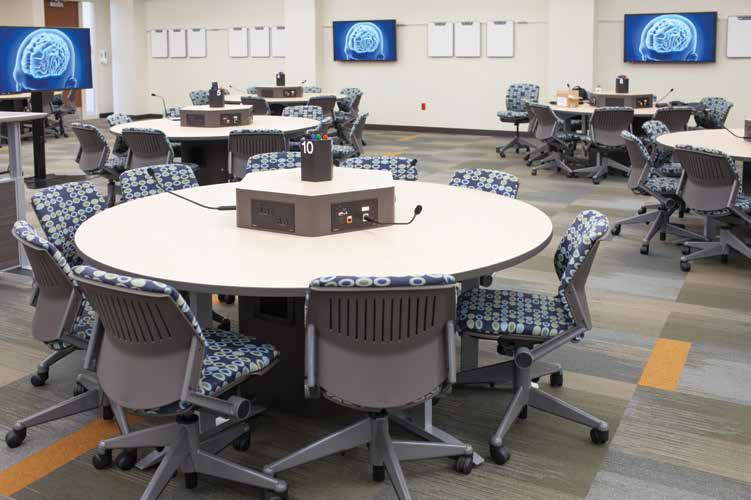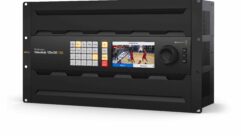

AV over IP: say it twice and it begins to sound like a mantra, one that’s mentioned whenever myriad facets of the industry are discussed, including the changing face of system architecture.
“We expect to see more clients moving toward a more centralized approach and minimizing in-room gear wherever possible,” said Zach Baxter, corporate sales manager, Presentation Products. “AV cabling infrastructure, whether it’s copper or fiber, is becoming indistinguishable from network infrastructure, and will more often be installed, terminated, and certified by data contractors rather than AV contractors.”
At CompView, the shift is toward becoming more IT educated, noted Mark Madison, vice president, technical services. “We are designing our cable infrastructure more like a structured cabling company. Centralized switching rack design is changing, and we need to understand IP switches and configuration better.”
The designs of his colleague, CompView AV designer and acoustical engineer Jerry Nuckolls, are mainly IP-based for control, with a healthy mix of IP-based video and traditional video. “I now prefer to use IPbased audio for its convenience and enterprise focus for distribution,” he said. “I see more and more staff opting for IP-based signals as they become more network savvy and aware.”
But wait, there’s more. The architecture does not really change significantly when using an IPTV system over an HDBaseT system, said Rod Andrewson, manager of technology and quality control, CCS Presentation Systems.
“The primary difference falls in the types of hardware needed, he explained. “The HDBaseT relies completely on equipment designed to manage the HDBaseT signals only. IPTV systems transmit signals over IT industry-standard switches and cabling. This one difference really is the driving force behind the exploding adoption of IPTV in the commercial AV marketplace.”
Most hardware and infrastructure fits into the everyday IT product list, Andrewson added. “The mystery of what and how the signals are pushed from one location to another is universally understood by those people who are required to manage the AV requirements of an organization: the IT staff.”
WHAT ABOUT BASEBAND VIDEO?
In many markets, baseband video already has been replaced by network infrastructure, Andrewson noted. “The hospitality industry has long adopted IPTV as the best means to manage content and information to the guest room. Security and video cameras are another market where baseband video just does not fit in anymore.”
Never say never, though. “It will be less expensive to keep native (and baseband) signals in many applications, Madison countered. “Some signals don’t benefit from being converted twice to IP.”
Baseband video can never be completely replaced, but certainly can be complementary to the network when broad distribution is needed between locations where traditional infrastructure is cost prohibitive, Nuckolls added. “There are advantages to passing video over category cable for its ease of installation, but legacy installations, secure installations, and realtime video will always have a place for non-network infrastructure.”
And there is a calculus between project size, cost, and desired complexity where HDBaseT systems will continue to be strong solutions, Baxter noted. “Huddle rooms are an example where the benefits of ‘sending any source to any display’ aren’t worth the cost and complexity for a room where a simple experience is preferred.”
PIECES WILL STAY OR GO
A switch is still a switch regardless of signal type, Madison noted. “The components really don’t change much. And there will always be a need to get dissimilar signals converted to a similar format.”
Television video service should change to IP distribution, Nuckolls stated. “Most are already doing this behind the scenes with digital video encoding and routing at cable distribution hubs. It only makes sense to get rid of the box and provide cleaner installation for enterprise users with IP-based video. Of course, enterprise groups need to be comfortable using those technologies.”
Video sources will, and already have, started to include a standard H.264 stream as an available output for video and audio. “Network switch manufacturers have started to adapt network switches to use rear-facing port formats to allow easier adoption into the AV world,” Andrewson noted.
And the bottom line remains that a key differentiator between integrators will continue to be the quality and intuitiveness of their user interface and control system programming, Baxter said.
PEER-TO-PEER
“Whether peer-to-peer or enterprise network design, we will need to continue to develop our networking knowledge to assist our clients in getting all these new AV products properly integrated into their environment,” Madison said.
And integrators should focus on being trained in networking similarly to those who might be considered systems administrators, Nuckolls added. “They should have the ability to understand Layer 2 and Layer 3 switching, the OSI model, firewalls, ports of access, security protocols, and what the implications are when clients are added to a network.”
WHAT’S NEXT
CobraNet and Dante have been rattling around on networks distributing audio for well over a decade, he added. “Control systems have done so as well. Video over IP and security cameras have been pushing compressed video over networks for years. Video-on-demand networks and IPTV has until recently been limited to large facilities and large-budget projects. This is changing as people are tired of the issues and limitations of the current technologies, and the cost of IPTV products decreases.”
Additionally, Andrewson said: “We are all becoming more knowledgeable about networking and how to design AV into it. What is next? Better compression technologies, and lower prices on the hardware and software as demand and volume build. We are already seeing this as many of the AV manufacturing players are jumping into the IPTV market very heavily. IPTV technology is an absolute must for commercial integrators moving forward.”










